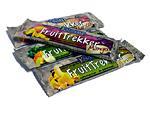
Recently on Cyclingnews.com |
Tech review - December 17, 2004
Fruit Trekker Bars
In developing the FruitTrekker bar, the boys at Kalahari have chosen to adopt the KISS principle - Keep It Simple, Stupid. Steve Beletich sampled the goods and agreed wholeheartedly.

|
Kalahari is a US-based food company, headed by a couple of guys with a penchant for the flavours of South Africa. Since 1999 they have been producing South African red teas and have recently introduced the FruitTrekker bar. The FruitTrekker philosophy can be summed up in four words: 'make fruit into bar'. In English, FruitTrekker bars consist of basic dried fruit with a small amount of rice flour to hold it together. They come in banana, mango, pineapple and apricot flavour, and each bar contains 120 Calories.
Now I'm a simple guy. Call me old fashioned, but when it comes to energy food, I'm a big fan of the bowl of porridge before riding, and the banana in the back pocket of my jersey. Oh, and several shots of espresso to feed the addiction (my problem, I'm dealing with it). [Problem, what problem? - Caffeinated Ed]
One thing I do understand however is glycemic index (GI). The GI rating of a food (measured on a scale from 1 to 100) indicates its blood glucose response. Eating high GI foods results in a short and high 'spike' in blood glucose level. Foods with a low GI break down slowly, releasing glucose more gradually into the blood stream over a longer period of time. Pure glucose has a GI of 100 and white bread has a GI of around 70. Low GI foods are defined as those with a GI of 55 or less.
As low GI foods tend to give you a more sustained energy boost, they are ideal for longer training rides. How does this relate to the FruitTrekker? The GI rating of banana, mango and apricot are low, at around 50, with pineapple slightly higher. There is also evidence to suggest that dried fruits also have a slightly lower GI than raw fruits.
So, due to the low GI of the key ingredient, dried fruit, FruitTrekkers should give you a sustained energy boost. This theory was put to the test during three medium-length training rides.
Opening the FruitTrekker packaging was a little tricky, especially at high speed in a large bunch. Getting the bar from packaging to mouth was a challenge - they're pretty mushy and tend not to hold their shape. These issues vanish if you're sensible enough to stop and eat the things at the side of the road. The good news was that after a couple of hours in my hot, sweaty jersey, and god knows how many weeks in the hot, sweaty Cyclingnews office before that, the FruitTrekkers were still edible.
The apricot bar was quite sweet, and consisted of chunks of dried apricot interspersed with apricot mush. A little too sickly sweet for me - makes it hard to swallow. The banana bar was not as sweet, and more chewy. It felt like several bananas compressed into a solid bar, and I found it easy to swallow at high cadence. Most importantly, it did not want to come up for an encore performance, as can occur with an over-ripe banana that's been squashed in your jersey for several hours and then shoved hastily into your gob during the downhill section. Reminds me of the comment I heard just prior to the bunch sprint the other day: "let the vomiting commence!". Tempting, but no thanks.
The mango FruitTrekker was quite chewy, again with hard and soft bits. I found it easy to digest with a sweetish taste. Ditto the pineapple. In the performance department, I definitely felt revitalised a short while after eating the FruitTrekkers. It wasn't a fast rush either, but seemed to sustain me for a good hour or so. Mission accomplished, as far as I was concerned.
In short, I found the FruitTrekker bars to be relatively easy to digest, with varying levels of taste satisfaction, depending on the chosen flavour. They all seemed to give me a sustained energy boost, however getting the bar from sealed packet to open mouth does carry a degree of difficulty at high speed.
(Footnote: Kalahari Foods has just signed on as a co-sponsor for one of North America's strongest pro racing teams, Jittery Joe's. Next year, the team will be known as the Jittery Joe's - Kalahari Cycling Team.).
Recommended retail price: US$1.50 (6 for $7.50)
Pros: All natural, low GI, good energy boost.
Cons: Ease of removal from packaging, soft consistency.
More information: www.kalahariusa.com
Cyclingnews Rating: ![]()

